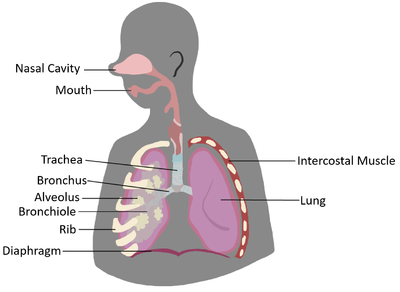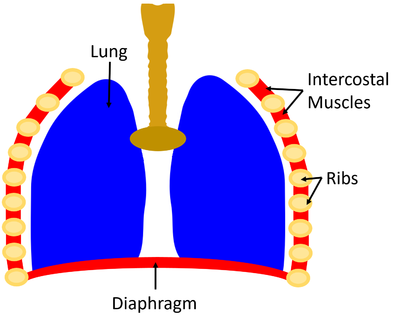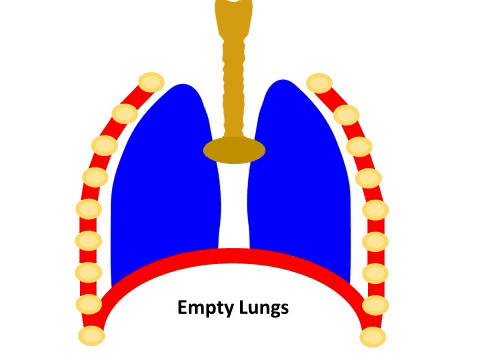Difference between revisions of "Breathing System"
| (9 intermediate revisions by the same user not shown) | |||
| Line 1: | Line 1: | ||
==Key Stage 3== | ==Key Stage 3== | ||
===Meaning=== | ===Meaning=== | ||
| − | The Breathing System is an [[Organ System|organ system]], that includes [[lung]]s used to [[Absorb (biology)|absorb]] [[Oxygen]] into the [[blood]] and remove [[Carbon Dioxide]] from the [[blood]]. | + | The [[Breathing System]] is an [[Organ System|organ system]], that includes [[lung]]s, used to [[Absorb (biology)|absorb]] [[Oxygen]] into the [[blood]] and remove [[Carbon Dioxide]] from the [[blood]]. |
===About the Breathing System=== | ===About the Breathing System=== | ||
| Line 22: | Line 22: | ||
|} | |} | ||
| − | Air enters the [[mouth]], travels down the trachea, through one of the bronchi, through a bronchiole and to an alveolus. [[Oxygen]] is transferred into the [[blood]] while [[Carbon Dioxide]] in the [[blood]] is transferred into the alveolus. | + | Air enters the [[mouth]], travels down the [[trachea]], through one of the [[bronchi]], through a [[bronchiole]] and to an [[alveolus]]. [[Oxygen]] is transferred into the [[blood]] while [[Carbon Dioxide]] in the [[blood]] is transferred into the [[alveolus]]. |
| + | |||
| + | ===Breathing=== | ||
| + | : To [[Breathing|breath]] the [[lung]]s must be able to take in new [[air]] and release the old [[air]]. | ||
| + | : When the [[lung]]s take in [[air]] this is called [[Inhale|inhalation]]. | ||
| + | : When the lungs get rid of old air this is called [[Exhale|exhalation]]. | ||
| + | |||
| + | {| class="wikitable" | ||
| + | |- | ||
| + | |[[File:Breathing.png|center|400px]] | ||
| + | |- | ||
| + | | style="height:20px; width:400px; text-align:center;" | | ||
| + | : To [[inhale]] the [[diaphragm]] [[contract]]s and goes down while the [[Intercostal Muscle|intercostal muscles]] [[contract]] pulling the [[Rib Cage|ribs]] upwards and outwards. | ||
| + | : To [[exhale]] the [[diaphragm]] relaxes and goes up while the [[Intercostal Muscle|intercostal muscles]] relax allowing the [[Rib Cage|ribs]] to go down and inward. | ||
| + | |} | ||
| + | |||
| + | {| class="wikitable" | ||
| + | |- | ||
| + | |[[File:Breathing.gif|center]] | ||
| + | |- | ||
| + | | style="height:20px; width:400px; text-align:center;" |An animation of the lungs inhaling and exhaling. | ||
| + | |} | ||
| + | |||
| + | ==Key Stage 4== | ||
| + | ===Meaning=== | ||
| + | The [[Breathing System]] is an [[Organ System|organ system]], used to [[Absorb (biology)|absorb]] [[Oxygen]] into the [[blood]] and remove [[Carbon Dioxide]] from the [[blood]]. | ||
| + | |||
| + | ===About the Breathing System=== | ||
| + | : [[Breathing System]]s are found in [[Amphibian]]s, [[Bird]]s, [[Mammal]]s and [[Reptile]]s. | ||
| + | : The [[Breathing System]] is specially [[Adaptation|adapted]] to exchange [[Absorb (biology)|absorb]] [[Oxygen]] into the [[blood]] and remove [[Carbon Dioxide]] from the [[blood]] as quickly as possible. | ||
| + | The parts in the [[Breathing System]] that you should know: | ||
| + | *[[Mouth]] | ||
| + | *[[Trachea]] | ||
| + | *[[Bronchus|Bronchi]] and [[Bronchiole]]s | ||
| + | *[[Lung]]s | ||
| + | *[[Alveolus|Alveoli]] | ||
| + | *[[Rib Cage|Ribs]] and [[Intercostal Muscle]]s | ||
| + | *[[Diaphragm]] | ||
| + | |||
| + | {| class="wikitable" | ||
| + | |- | ||
| + | |[[File:BreathingSystemDiagram.png|center|400px]] | ||
| + | |- | ||
| + | | style="height:20px; width:400px; text-align:center;" |A diagram showing the parts of the human [[Breathing System]]. | ||
| + | |} | ||
| + | |||
| + | Air enters the [[mouth]], travels down the [[trachea]], through one of the [[bronchi]], through a [[bronchiole]] and to an [[alveolus]]. [[Oxygen]] is transferred into the [[blood]] while [[Carbon Dioxide]] in the [[blood]] is transferred into the [[alveolus]]. | ||
| + | |||
| + | ===Breathing=== | ||
| + | : To [[Breathing|breath]] the [[lung]]s must be able to take in new [[air]] and release the old [[air]]. | ||
| + | : When the [[lung]]s take in [[air]] this is called [[Inhale|inhalation]]. | ||
| + | : When the lungs get rid of old air this is called [[Exhale|exhalation]]. | ||
| + | |||
| + | {| class="wikitable" | ||
| + | |- | ||
| + | |[[File:Breathing.png|center|400px]] | ||
| + | |- | ||
| + | | style="height:20px; width:400px; text-align:center;" | | ||
| + | : To [[inhale]] the [[diaphragm]] [[contract]]s and goes down while the [[Intercostal Muscle|intercostal muscles]] [[contract]] pulling the [[Rib Cage|ribs]] upwards and outwards. | ||
| + | : To [[exhale]] the [[diaphragm]] relaxes and goes up while the [[Intercostal Muscle|intercostal muscles]] relax allowing the [[Rib Cage|ribs]] to go down and inward. | ||
| + | |} | ||
| + | |||
| + | {| class="wikitable" | ||
| + | |- | ||
| + | |[[File:Breathing.gif|center]] | ||
| + | |- | ||
| + | | style="height:20px; width:400px; text-align:center;" |An animation of the lungs inhaling and exhaling. | ||
| + | |} | ||
Latest revision as of 14:12, 21 February 2022
Contents
Key Stage 3
Meaning
The Breathing System is an organ system, that includes lungs, used to absorb Oxygen into the blood and remove Carbon Dioxide from the blood.
About the Breathing System
- Breathing Systems are found in Amphibians, Birds, Mammals and Reptiles.
- The Breathing System is specially adapted to exchange absorb Oxygen into the blood and remove Carbon Dioxide from the blood as quickly as possible.
The parts in the Breathing System that you should know:
| A diagram showing the parts of the human Breathing System. |
Air enters the mouth, travels down the trachea, through one of the bronchi, through a bronchiole and to an alveolus. Oxygen is transferred into the blood while Carbon Dioxide in the blood is transferred into the alveolus.
Breathing
- To breath the lungs must be able to take in new air and release the old air.
- When the lungs take in air this is called inhalation.
- When the lungs get rid of old air this is called exhalation.
|
| An animation of the lungs inhaling and exhaling. |
Key Stage 4
Meaning
The Breathing System is an organ system, used to absorb Oxygen into the blood and remove Carbon Dioxide from the blood.
About the Breathing System
- Breathing Systems are found in Amphibians, Birds, Mammals and Reptiles.
- The Breathing System is specially adapted to exchange absorb Oxygen into the blood and remove Carbon Dioxide from the blood as quickly as possible.
The parts in the Breathing System that you should know:
| A diagram showing the parts of the human Breathing System. |
Air enters the mouth, travels down the trachea, through one of the bronchi, through a bronchiole and to an alveolus. Oxygen is transferred into the blood while Carbon Dioxide in the blood is transferred into the alveolus.
Breathing
- To breath the lungs must be able to take in new air and release the old air.
- When the lungs take in air this is called inhalation.
- When the lungs get rid of old air this is called exhalation.
|
| An animation of the lungs inhaling and exhaling. |


